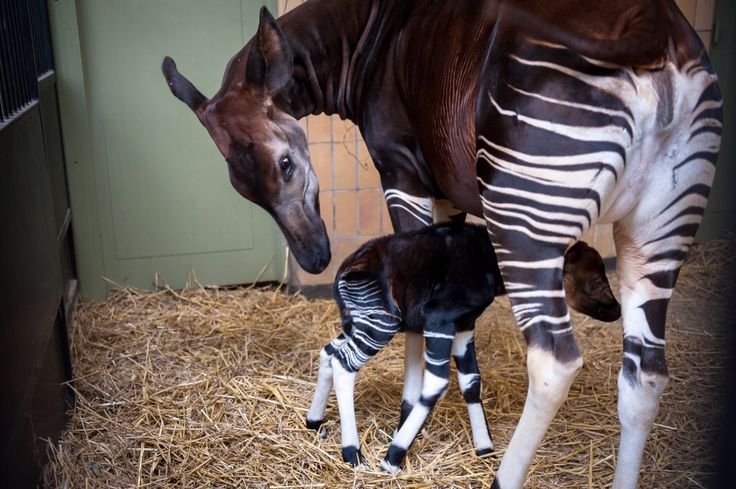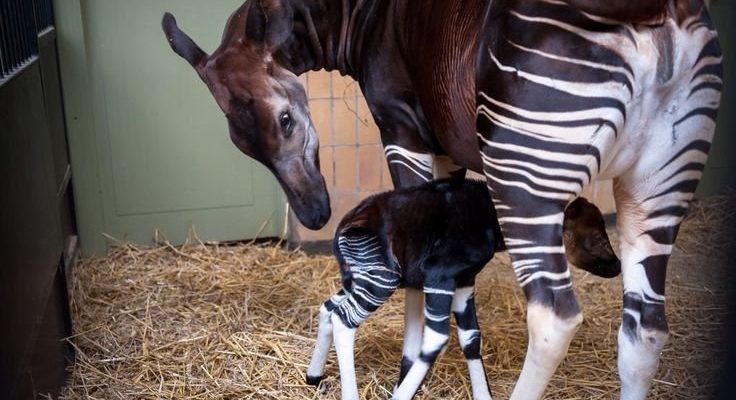
Raising young okapis is a whole different ball game. In the wild, these creatures have to navigate threats from predators while ensuring their calves grow strong and healthy. So, how do they manage this? Let’s dive into the incredible world of okapi parenting, exploring their behaviors, challenges, and the remarkable bond between mother and calf.
The Birth of a Calf
When an okapi gives birth, it’s a delicate process. The gestation period lasts about 15 months, which is quite long compared to many other animals. Once the moment arrives, the mother typically seeks out a secluded spot in the forest, away from other animals and potential dangers. This choice is crucial; it provides a safe environment for the vulnerable newborn.
After a relatively short labor of about an hour, the calf is born. At birth, it’s about 2.5 feet tall and weighs around 60 pounds. Now that’s a hefty little one! The mother helps the calf by licking it clean, which not only keeps it warm but also helps it bond with her. Newborn okapis are quite helpless at first, but they’re instinctively designed to hide, blending perfectly into the dappled light of the forest floor.
Mother-Child Bonding
Once the calf is born, the mother and young start to build an inseparable bond. For the first few weeks, the mother stays close to her calf, nursing it with her rich milk. This milk is packed with nutrients, helping the calf gain strength quickly. You might be wondering how long this lasts. Well, calves typically nurse for about six months, but they start nibbling on leaves and twigs soon after they are a few weeks old.
Here’s an interesting tidbit: Okapis are known for their strong maternal instinct. The mother will protect her calf fiercely. If she senses danger, she’ll often lead her calf away into safe, hidden areas of the forest. This instinct is crucial because, despite being elusive, okapis face threats from predators like leopards and humans. The bond they form is as much about love as it is about survival.
Hiding and Survival Skills
As we mentioned, hiding is one of the key survival strategies for young okapis. The calf instinctively knows to stay quiet and still, just like a little ninja, which helps it avoid detection by predators. This skill is vital, especially in those initial weeks of life, when they’re most vulnerable.
Mothers play a pivotal role in teaching their young how to navigate their environment. As the weeks go by, the mother will lead her calf to different feeding areas. These locations are often rich in leaves, fruits, and other vegetation the okapis love. It’s like a culinary school for calves! They learn by watching their mothers eat and then mimic the behavior, picking up the necessary skills to find food on their own.
Growing Up: The First Year
As calves grow, they undergo significant changes. By the time they reach six months old, they begin developing their distinctive stripes, which help camouflage them in the forest. This is also when the mother starts to encourage independence. You might notice she allows her calf to wander a bit farther from her side, testing its confidence and skills.
Around one year of age, the young okapi is more independent but still relies on its mother for protection and guidance. The bond they share remains strong, helping the calf learn how to interact with its surroundings, avoid dangers, and prepare for adulthood. Interestingly, mother okapis and their calves will often stay close together even after weaning, showcasing a strong emotional connection.
The Role of the Forest Habitat
The okapi’s habitat plays a critical role in their parenting strategies. Living in dense, tropical forests provides both cover and abundant food sources. The thick foliage acts as a shield against predators, allowing mothers to raise their young with a bit more peace of mind.
However, deforestation and habitat loss pose severe challenges. As human activities encroach on their territories, okapis find it harder to raise calves safely. The forest’s health is directly linked to the success of okapi reproduction and the survival of their young. Conservation efforts are essential to ensure these unique creatures can continue raising their young in the wild.
Raising young okapis in the wild is a complex dance of nurturing, survival, and adaptation. From the moment they’re born, these calves are enveloped in a world that requires not just maternal love but also the savvy to survive in a rich yet dangerous forest environment.
The future of the okapi species largely hinges on continued conservation efforts to protect their habitats. By understanding their unique parenting strategies and the challenges they face, we can better appreciate these incredible creatures and help ensure that future generations of okapis will thrive in their wild homes.

